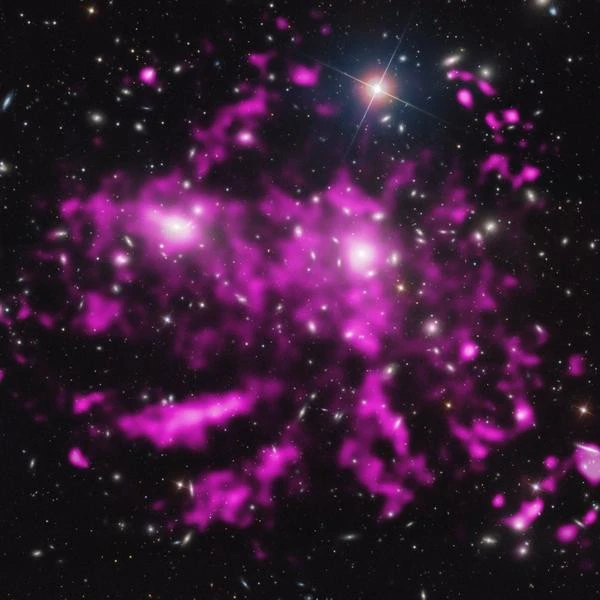
Image description: The image of the Coma galaxy cluster is very interesting because it shows thousands of galaxies, not in an empty universe but amidst gigantic bubbles of hot gas, visible thanks to the Chandra X-ray space telescope. This gas fills the space between the galaxies and represents a much greater mass than the galaxies themselves. Credits: X-ray: NASA / CXC / MPE / J. Sanders et al; optical: SDSS.
Galaxy clusters are the largest observable structures in our Universe. They consist of hundreds of galaxies, bound together by their own gravitational attractions.
Between the galaxies, there is a lot of matter, much more matter than within the galaxies themselves. This matter consists of gas of varying temperatures and dust grains. The hot gas, whose temperature can reach 100 million degrees, forms a plasma, which is a soup of matter where electrons are separated from nuclei. In this low-density soup, with 1000 particles per cubic meter, there are only charged particles, in other words, separated ions and electrons. This plasma is a strong emitter of X-rays.
Observations of the velocities of the galaxies and the intracluster gas show that the visible mass (stars, gas) is not enough to explain the observed gravitational forces. The majority of the cluster's mass is therefore attributed to dark matter.
The Coma Cluster is a galaxy cluster. It is spherical, very dense at its center, and contains more than 1000 identified galaxies. It is located 300 million light-years away, along with the Virgo Cluster in the constellation of Virgo.
These enormous arms of hot gas seen in the Coma galaxy cluster cover at least half a million light-years. This field of view gives us an insight into how the Coma Cluster has grown and continues to grow through mergers of small groups of galaxy clusters. It is currently one of the largest structures in the Universe held together by gravity. The optical data of this composite image show hundreds of galaxies belonging to the Coma Cluster.
All these assembled galaxies represent little mass compared to the entire gaseous cosmic structure. They contain only about one-sixth of the mass of the hot gas. Furthermore, in this image processed using Chandra's data, we only see the brightest X-ray emissions. In reality, the hot gas completely fills the field of view.
Researchers believe that these gigantic arms probably formed with the gas lost by the galaxy clusters in their movement. The gas was stripped away by the "winds" created by the movement of the galaxy cluster. In the enlarged image, one can see galaxies trailing behind them a cloud of hot gas (in pink).
Coma is an unusual galaxy cluster because it contains not one, but two giant elliptical galaxies near its center. These two giant elliptical galaxies are likely the result of past mergers of small groups of galaxies. Most theoretical models predict that mergers between groups like those in Coma produce strong turbulence, like on the surface of the sea churned by the passage of many ships. Observations of the Coma Cluster show that these long, smooth arms of hot gas are in a rather calm setting, even after numerous mergers. Although the amount of turbulence in a galaxy cluster is difficult to estimate, astrophysicists believe that large-scale magnetic fields are probably responsible for the low levels of turbulence present in Coma.
The dynamics of the galaxies within the Coma Cluster are dominated by the gravity of dark matter. The speed of the galaxies can reach several hundred kilometers per second, indicating a total cluster mass of about \(10^{15}\) solar masses.
These data on the Coma Cluster were obtained after more than six days of observation time. An article on the Chandra observations was published in the September 20, 2013 issue of Science. The lead author of the article is Jeremy Sanders, from the Max Planck Institute for Extraterrestrial Physics in Garching, Germany.